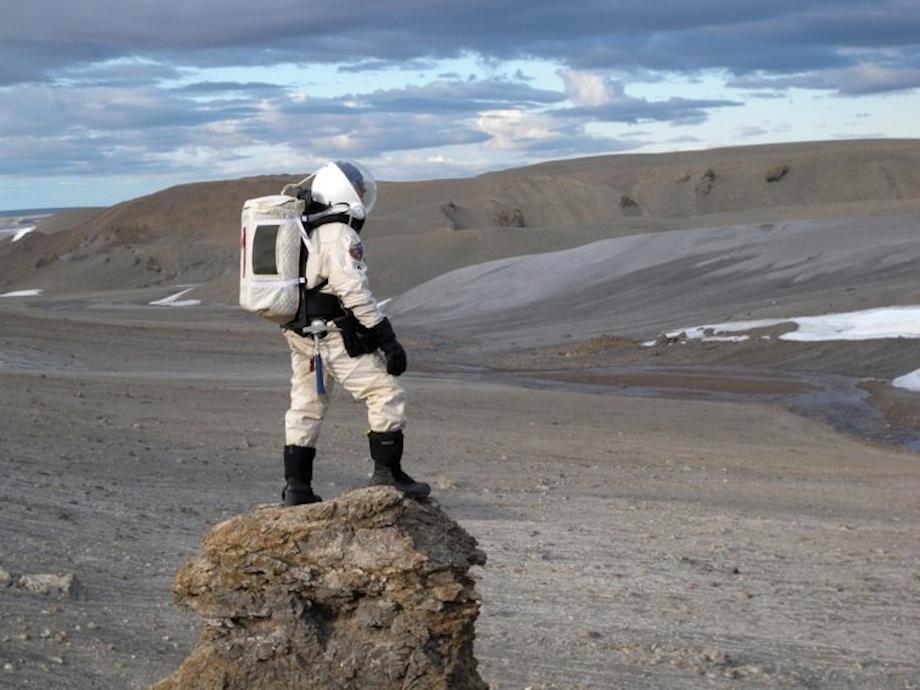Life on Mars?
Right now, the population on Mars is zero, at least if you don’t count the rovers hanging out on the fourth planet from the sun. And, at least for the foreseeable future, the population on Mars will remain zero. And there’s a good reason for that. To begin with, Mars isn’t easy to get to. According to NASA, via Space.com, “a one-way trip to Mars would take about nine months. If you wanted to make it a round-trip, all in all, it would take about 21 months as you will need to wait about three months on Mars to make sure Earth and Mars are in a suitable location to make the trip back home.” And that three-month stay would be brutal. There’s nothing to eat or drink except for some patches of ice, you can’t breathe the air, and temperatures average -81°F (-63°C), and there’s no way to get more supplies once yours run out or break. An astronaut on Mars would be bundled in a spacesuit while overlooking an endless, rocky terrain.
It would look something like this.

That’s a photo, not an artist’s rendition of what life on Mars may look like. But, of course, the person in the astronaut’s gear isn’t actually on Mars. He’s not even an astronaut. (I typoed that as “astronaught” at first and really should have kept it — he is, as you’ll see an astro-naught.) The man in the suit above is Brian Shiro, and as he recounted on his blog in 2009, Shiro was stationed on Devon Island, the closest thing we have on Earth to Mars.
Devon Island is a Canadian island in the Arctic Circle (here’s a map). It has no permanent human population and, as far as we know, never has, and for good reason — it’s a rocky wasteland. According to the Mars Institute, the island is a polar desert — it is “is both very cold and dry” — and is “the single largest continuous area of barren rocky polar desert on Earth.” It is also home to the Haughton impact crater, a 14-mile (23-km) wide crater that’s been around and mostly untouched for more than 20 million years. All in all, Devon Island isn’t a great place to live or to go on vacation.
And yet, every summer, a bunch of researchers like Shiro ends up spending a few months there. Why? Because it’s as close as we can get to Mars without leaving Earth. As NASA explains, the island’s “harsh climate mimics the environmental conditions on Mars and other planets. Devon Island’s barren terrain, freezing temperatures, isolation, and remoteness offer scientists and personnel unique research opportunities.” That makes it a good place for researchers — and probably, as good as it gets — to study what life would be like on Mars, at least without having to launch people on a months-long space cruise to the middle of nowhere.
So, in 1997, a consortium of countries and nonprofits set up what is now known as the Haughton–Mars Project. Researchers spend a month on the site, living in conditions designed to simulate a trip to Mars. Rod Pyle, a journalist for Space.com, was invited to participate in the Summer 2022 trip, and even packing was an ordeal: “we’re restricted to 50 pounds (22.6 kilograms) of checked baggage for personal effects and a single carry-on. In normal travel, this is not a challenge since anything forgotten or overlooked can be picked up at a nearby Walmart or mom-and-pop store. But on Devon, we’ll be dealing with whatever we carry in, so cold weather clothing is critical, and anything mechanical or electronic can likely not be replaced.” And once on-site, things get even more difficult. As Slate explained, one summer, the participants “experiment[ed] with ‘Low Level Laser Light Therapy’ as a way to keep future Mars explorers limber during long exposure to the cold, and simulated emergencies such as depressurization, fires, and toxic chemical leaks.” And, of course, when you go outside, you’re supposed to be wearing your pseudo-spacesuit, as seen above.
If you’re interested in going there, well, that’s not likely to happen — while there are some opportunities for non-researchers to help out, Devon Island is still pretty far away and access is limited. Google Earth, though, can give you the next best thing to the next-best version of Mars. They have a virtual walkthrough of Devon Island and the Haughton impact site, which you can do from the comfort of your own home, here.
Bonus fact: While no one has been to Mars, we know a lot more about it than you’d think — even compared to what we know of our own planet. Because most of the Earth is covered in water, and because we can’t breathe underwater without assistance (and for other reasons, too), what’s under our oceans is a bit of a mystery. National Geographic explains just how little we know: “More than 80 percent of the ocean has never been mapped, explored, or even seen by humans. A far greater percentage of the surfaces of the moon and the planet Mars has been mapped and studied than of our own ocean floor.”
From the Archives: Mission to Nowhere: A simulated trip to Mars… and it’s about as fun as you’d think.
